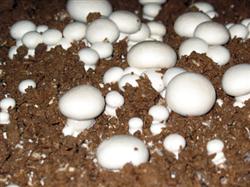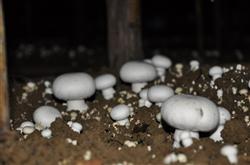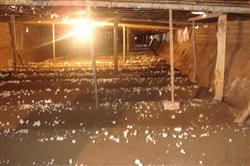Causes and preventive measures of common problems in the outbreak period of Pleurotus ostreatus

After sowing, the hyphae do not germinate, do not eat food, grow poorly, and even atrophy and die. ① strain: the bacteria used are aging and degraded; poor quality; injured by high temperature or high humidity; carrying disease and insect pathogens; warm type discomfort, etc. Mushroom farmers must purchase seeds carefully. ② medium: improper preparation of culture materials, imbalance of carbon to nitrogen ratio leads to insufficient nitrogen or excessive nitrogen fertilizer, which makes it difficult for bacteria to colonize and grow and suffer damage. The culture material should be prepared reasonably, the fermentation process should be strict, the nitrogenous fertilizer should be added when turning the pile for the first time, the waste gas should be removed before sowing, and the pH should be checked. ③ humidity: the medium was too wet or too dry before sowing. Too wet, resulting in insufficient oxygen supply of mycelium, decline in vitality; over-dry, mycelium feeding difficulties, water loss and shrinkage. If the bacteria are covered with film after sowing, the surface bacteria will be "drowned" because the film is not ventilated in time. Attention should be paid to mastering the moisture of the culture material, and the method of spreading or adding water can be used to adjust it when turning the pile for the third time. ④ temperature: the germ temperature is too high or too low. The post-fermentation is not complete, which leads to the increase of the heap temperature after sowing, the temperature of the material does not drop to less than 30 ℃ before sowing, and the high temperature of the greenhouse during the sterilization period will lead to high temperature "burning bacteria". When the temperature of the shed (material) is below 8 ℃, it is difficult for the strain to grow. ⑤ pests: harmed by mites, nematodes and other pests. When the density of insect population reaches 500000 per square meter, the hyphae will break, shrink and die. The fermentation process should be strict, especially the post-fermentation, and the covered soil should be disinfected. The hyphae grow excessively after being covered with soil. After the bacterial bed is covered with soil, the villous mycelium grows vigorously and often emerges from the soil surface, forming a dense, impervious white "fungus quilt", which consumes nutrients and hinders the normal emergence of mushrooms. The main reasons are as follows: improper preparation of ① culture materials, excessive nitrogen, or excessive maturity of culture materials, many available components, and excessive vegetative growth after sowing. ② suffered from high temperature and high humidity, poor ventilation, early sowing date, and the feed temperature was above 20 ℃ for a long time after sowing, which was beneficial to the growth of mycelium but not to the formation of fruiting body. When ③ used aerial type varieties, too many aerial hyphae were picked in the process of seed production, and the culture temperature of producing seeds was too high, and there were too many aerial hyphae in the upper part of the bottle mouth. The moisture of ④ overlying soil layer is dry inside and wet outside. A reasonable formula should be chosen. When the hyphae grow out of the overlying soil layer, it is necessary to strengthen ventilation, reduce temperature and humidity, and spray "mushroom water" in time to facilitate the formation of primordia. Do not spray water too quickly, but in the morning and evening when it is cool. Once the mycelium is found to be overgrown, scratch or pick out the quilt slightly with a knife or bamboo, and cover the soil with a new layer. -- the hyphae can not go up to the soil after covering the soil and transferring water. After 10 days of mulching, the hyphae did not go to the soil, showing grayish white, thin and weak. In serious cases, the hyphae could not be seen on the bed, and even the material surface was black. The main reasons are as follows: the water used in ① is too fast or too large, and the water infiltrates into the culture material, resulting in the disconnection between the material layer and the mycelium of the soil layer, resulting in "intercalation". Continuous water transfer at high temperature above 25 ℃. Ventilation is not timely, so that the mycelium is in a state of high temperature, high humidity and hypoxia for a long time, resulting in mycelium decay, yellowing and loss of vitality. The pseudo-wet phenomenon of too little water content in ③ soil layer. The heat preservation performance of ④ mushroom house is poor or the soil layer on the bed surface is exposed to excessive wind. ⑤ material surface or soil layer spray too much or too thick, resulting in drug damage caused by ⑥ diseases and insect pests infection and destruction. There is a great difference in acidity and alkalinity of ⑦ soil layer. Appropriate adjustments should be made according to the above reasons.
- Prev

Double-spore mushroom spray water must be "five look"
Look at the weather. Sunny and dry weather or when the temperature is appropriate should spray more water; rainy weather or when the temperature is high, low should spray less or stop spraying water. Second, look at the mushroom house situation. The mushroom house with serious air leakage and poor heat preservation should spray more water and less ventilation; the mushroom house with no serious air leakage and strong moisture retention should spray less water and pass more water.
- Next

Integrated control of diseases and insect pests of Pleurotus ostreatus
1 miscellaneous bacteria, diseases, insect pests and their control 1.1 miscellaneous bacteria and their control methods 1.1.1 Ghost umbrellas are commonly known as wild mushrooms, morphological characteristics: the cover is initially warhead-shaped or oval, jade white, gray-white or yellow-white, with scales on the surface, slender stalks and hollow. When the mature fungus cap unfolds, the fold changes gradually from white to black.
Related
- Fuxing push coffee new agricultural production and marketing class: lack of small-scale processing plants
- Jujube rice field leisure farm deep ploughing Yilan for five years to create a space for organic food and play
- Nongyu Farm-A trial of organic papaya for brave women with advanced technology
- Four points for attention in the prevention and control of diseases and insect pests of edible fungi
- How to add nutrient solution to Edible Fungi
- Is there any good way to control edible fungus mites?
- Open Inoculation Technology of Edible Fungi
- Is there any clever way to use fertilizer for edible fungus in winter?
- What agents are used to kill the pathogens of edible fungi in the mushroom shed?
- Rapid drying of Edible Fungi

